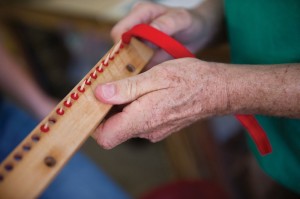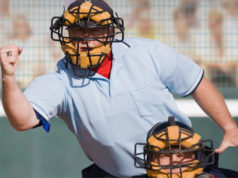“A few months after that, I took the exam, which included tuning a piano, and passed,” he recalled.
The novice’s first test followed shortly. A close friend, Charles Bybee, was in a bad car wreck and needed someone to fill in for him in his piano technician job while he recovered.
Hufford was now being pulled in two directions. On one hand, he was making progress in college, first as a composition major, then as a theory major while studying with Kraus. On the other hand, he was well into his 20s and about to marry and start a family.
But life and a little bad luck were beginning to nudge him away from performance. In order to enter the 1977 Van Cliburn International Piano Competition, Hufford was relying on a provision in the contest rules that would allow him to subtract the time he served in the military from his age. He was 30 at the time, and the cut-off was 29. At the last minute a director from the foundation told him the rule had been rescinded due to the difficulty of verifying the military records of foreign competitors.
“Then my daughter Elizabeth was born,” he said. “I had to make a living is what it boiled down to.”
Years later, Hufford got a taste of the dream he’d had to abandon. In 1986 he gave a ticketed concert at the W.E. Scott Theater in the Cultural District.
Gordon still recalls the poise and polished sound of his friend performing works by Bach, Liszt, and Schumann that night.
“It was clear that was what he always wanted to be, he recalled. “He was very professional and in his element.”
******

Every bit of energy Hufford had focused on performing was now thrown into learning the history and most minute details of the piano. He had almost enough credits for a bachelor’s degree, but college had to be put on hold while he mastered this new discipline in order to support his family. He has never finished that degree.
In 1991 Hufford almost died in a car wreck. A distracted driver pulled out in front of him as he drove at a fast clip in a new Lincoln sedan. His daughter Elizabeth, who was in the front passenger seat, hadn’t put on her seatbelt when the other car crashed into the driver’s side of the Lincoln.
“I remember telling Elizabeth to put her seatbelt on,” he recalled. “ ‘OK, Dad, she said.’ All I remember is hearing that noise [of the crash].”
The last feeling he remembers before the impact knocked him unconscious was terror that his daughter was going to die. When he came to, he saw her red hair near his feet. His 13-year-old daughter had crawled under the dash to press the brake pedal and stop the car from rolling down an embankment. Miraculously, she suffered only minor bumps and bruises. Hufford, however, had sustained a massive concussion whose effects manifested over the next three days. Without medical insurance, he toughed it out but was unable to work for several months, suffering debilitating vertigo and short-term memory loss.
Hufford recovered and slowly built a reputation that brought him into the city’s great concert halls and into contact with many of the greatest pianists alive. The career also took him to the homes of Cliburn, Mercedes Bass, and others.
Over the decades he has bought, restored, and sold countless pianos dating as far back as the early 19th century. But in 2005 a faulty light nearly destroyed everything he had worked to build.
The day started like any other. Gordon and his wife Mary had invited Hufford to visit a local antique shop. At the last minute he decided to take his puppy Skippy out of the workshop and put him in his car, leaving the window open a little.
An hour later, returning to Hufford’s shop near Hwy. 377 and Loop 820, the friends noticed a small crowd gathering. At first, the three thought one of the cabinetmaking businesses around Hufford Piano Services had caught fire, as such businesses are prone to do. But as they got closer, the reality became all too clear.
“As we found out later, the fire reached 1,000 degrees,” he recalled. “When I got there, firemen were just hauling stuff out. I ran right in — and was hit by a hot, humid mix of smoldering embers and wood.”
A fireman ordered him to get out or be arrested. His shop was now a potential crime scene. All he could do was stand outside and look at his pianos, burned and soaked with water.
“Finally, a fire marshal arrived and declared the fire an accident,” he recalled. “I thought, ‘You’re goddamn right it’s an accident,’ ” — but he bit his tongue.
As the crowds dispersed, he was finally able to gauge the damage. The fire, as investigators later found, had started near the entryway. A portable light fixture had shorted, spewing molten copper onto a wooden cabinet stuffed with paperwork. From there, the fire crept upward and along rows of cabinets and miscellaneous wooden piano parts. The inferno was contained by walls of sheetrock, but the intense heat had melted the tar on the ceiling, which rained down and adhered to every piano below.
Eight grand pianos were completely destroyed, and 37 had smoke and water damage. The total loss was $80,000, not including the $11,000 Hufford spent from his own pocket in investigating the cause of the fire.
Jim and Mary were the only help he had on that chaotic evening. They did what they could to dry out the pianos that had been flooded with water. Ironically, Hufford had been unable to get fire insurance because his shop was surrounded by cabinet shops that were at higher risk for fire.
“We salvaged as much as we could, but a bunch of his pianos were destroyed,” Gordon said. “He was very upset, but he has a tremendous amount of resiliency.”
Hufford is only now recovering from the devastation. His staff worked tirelessly at the time, moving all the damaged pianos to an adjacent room before clearing, cleaning, and repainting the main workroom. Even today, the faint scent of smoke permeates the area.
Hufford never could prove that the manufacturer of the light fixture was to blame for the fire. In the end, the owner of the building paid for half of the investigation costs, and Hufford had to swallow the remaining losses.
Among the pianos in the shop that day was a rare 1930s Chickering concert grand, Model 141. That piano, mercifully spared, would serve as the basis for the next chapter in his career.
******
Hufford’s two great loves, history and music, coalesce in his current collection of grand pianos and uprights. In many ways, his workshop is a museum, full of examples of major advancements in piano technology that unfolded across Europe and the United States over the past two centuries. In an adjacent storage unit sits an 1857 American piano that is surprisingly modern in its look and construction. The antique piano’s system of hammer and levers, called the Brown Action, transfers the force of a pianist’s hand to the strings in a manner similar to that employed by modern-day counterparts. That action, now being restored by Hufford and his team, is a window into time.
The first piano action was developed by Bartolomeo Cristofori around the year 1700 in Italy and differed from the harpsichord that preceded it in the way notes were produced from the strings. Rather than using quills to pluck the strings, the piano uses hammers to strike them. The advantage was an increase in volume and control over variations in the sound level, referred to as “dynamics” by musicians. Even the instrument’s full Italian name, piano forte, translates to “soft, loud.”
From there, the action’s design was improved and modified by technicians in Britain, Germany, and France to meet the demands of ever more virtuosic pianists like Mozart and ever larger concert halls. With the advent of the Industrial Revolution, the availability and quality of iron enabled the next crucial leap in piano technology. That advancement, the cast-iron plate, would occur an ocean away in a fledgling former British colony.
As pianos grew throughout the 19th century, their workings began to test the limits of European-designed wooden frames. The long strings inside pianos are under immense tension, like guitar strings screwed too many times. Only the piano’s frame keeps it from being pulled to pieces.
In 1837 an American piano manufacturer named Jonas Chickering devised an iron plate that could sustain the thousands of pounds of tension that pianos of that day were demanding. Chickering was a cabinet manufacturer who applied his skills to instrument-making and founded the piano manufacturing firm Chickering and Sons. Decades later, a German-American immigrant named Henry Steinway added two more advancements: a laminated rim to encase the new iron plate and a new arrangement that allowed for longer, more powerful bass strings. The modern piano is an American invention, and through his refurbishing of early 20th- century pianos, Hufford is preserving an almost-lost period in the instrument’s development.
“This is all forgotten now,” he said. “American piano production had been increasing for 50 years leading up to the 1920s, with annual sales peaking around 200,000 to 300,000 units. That was a lot for a North American market of 80 million to 100 million people. When amplification and radio came up in the ’20s, the piano market began to contract. Pianos were much more integral in family life up until that point. It wasn’t because of the Depression.”
Hufford found that not only were piano sales increasing as the Great Depression approached, but so was the instrument’s quality, led by innovations from Steinway & Sons and Chickering. The hammers produced by Steinway were unmatched in quality, he said, but the best overall piano was made by the now largely forgotten Chickering company, a grand piano simply called the 141. Its action was faster and more responsive than anything that came before, he said, and innovations in the piano’s construction and design gave it mellifluous, bell-like tones that Hufford said are without equal.
In his research, Hufford found that Chickering produced up to 250 Model 141s before going bankrupt in 1929. With the loss of the venerable piano manufacturer, the innovations that had peaked with the 141 were all but forgotten.
He learned about the Chickering 141 by accident. Several years ago he happened upon and bought a 1920s era Kimbell grand piano that had been part of historic Boardwalk Hall arena in Atlantic City. Only then did he learn that New Jersey state officials had been searching for that very instrument. After negotiating, the state officials offered him two Steinways and a Chickering 141 in trade.
“The State of New Jersey had decided to rebuild Broadway Hall,” Hufford recalled. “They wanted to rebuild it just like it had been in 1929, and they wanted to rebuild the ballroom with a Kimbell.”
When the three pianos made their way to Fort Worth, Hufford had a chance to closely examine and practice for hours on the rare Chickering.
“Steinway is the cat’s meow in the public’s perception, but Chickering more than gave them a run for their money,” he said. Whereas Steinways have a little darker tone, the 141 has a “bright, clear” tone, he said.
He hopes his restoration efforts will revive knowledge of the 141 and other pianos from that time period. Among his various projects, the veteran tuner is now writing a history of pianos from the 1920s and ’30s. He even hopes one day to open a museum in honor of these forgotten instruments.
Doug Kirk, stage manager at Bass Performance Hall, has worked with Hufford for the past 12 years. He said he’s never seen a more reliable and likable piano technician than his friend and colleague.
“I can call him at 8 a.m. on a Friday [with a last-minute job], and he’ll be here at noon,” he said.
Four years ago, the popular New Age pianist Jim Brickman gave a performance on the hall’s Yamaha concert grand. Brickman was so impressed with the work Hufford had done that he offered to buy the piano on the spot.
“It was a credit to Robin’s work,” Kirk said. “But we couldn’t sell him our piano,” he added with a chuckle.
Gordon and Hufford still play chess and reminisce. After decades of friendship, Gordon has a deep grasp of Hufford’s passion for pianos.
The memory of hearing a piano for the first time as a child still shapes Hufford’s life, but little about that journey has been easy.
“He had a pretty hard childhood, and I think music was an escape for him,” Gordon said. “Music is a world of beauty and aesthetic appreciation. Once he found his way into music, it became his life’s work.”












Excellent writing, Eddie.
I own a Chickering 141 and it is one of the best pianos i have ever had the privilege to play and own.
The middle and top are bell like in sound and the bass is wonderful as well. It was totally rebuilt by a master technician about 14 years ago.
john gallagher